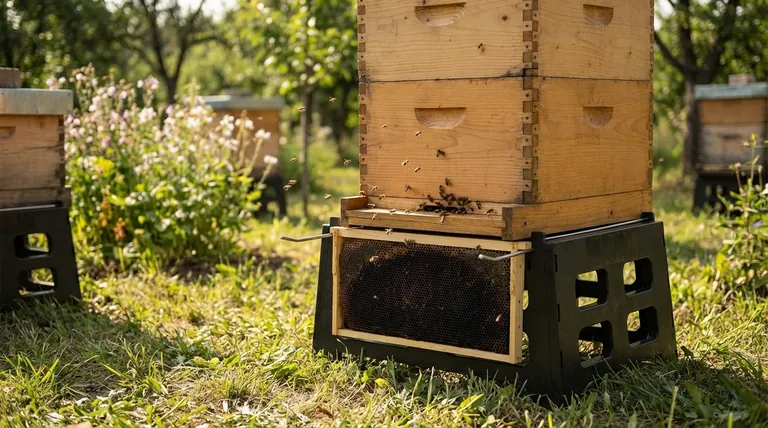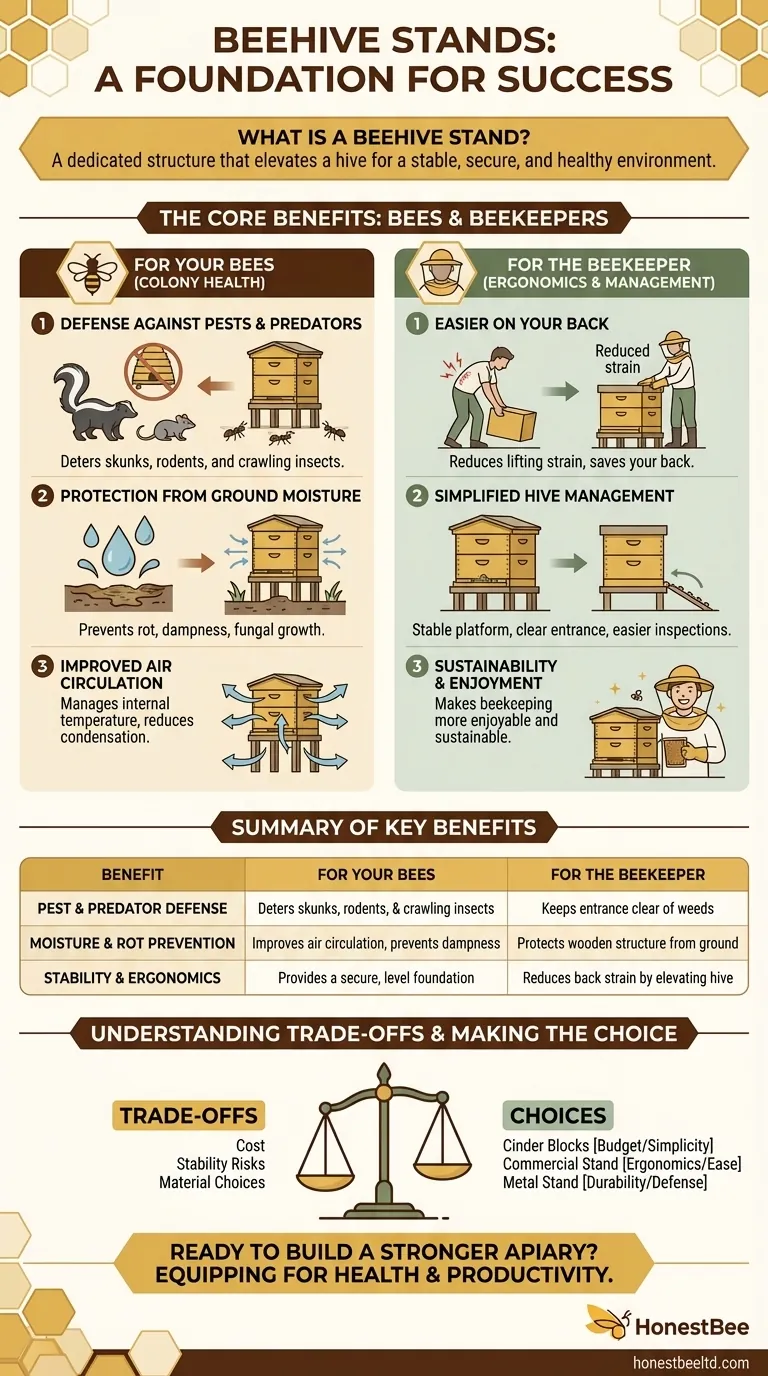In short, a beehive stand is a dedicated structure that elevates a beehive off the ground. Its primary purpose is to create a more stable, secure, and healthy environment for the honeybee colony while also making the hive easier and more comfortable for the beekeeper to manage.
A beehive stand is not merely a piece of furniture for your apiary; it is a fundamental tool for proactive hive management that directly impacts colony health, pest defense, and the physical ease of beekeeping.

The Core Benefits for Your Bees
A properly selected stand is your first line of defense in maintaining a thriving colony. It directly addresses several environmental threats that can weaken or destroy a hive.
Defense Against Pests and Predators
Raising a hive just 12-18 inches off the ground creates a significant barrier for common threats. It helps deter skunks, which prey on bees at the hive entrance, and makes it more difficult for mice and other rodents to seek shelter inside during winter.
It also limits access for crawling insects like ants, which can rob a hive of its resources.
Protection from Ground Moisture
Direct contact with the ground exposes the hive's wooden components to constant moisture. This leads to wood rot, which compromises the structural integrity of the hive and creates a damp internal environment.
A stand allows air to circulate underneath the bottom board, keeping the hive dry. A dry hive is crucial for preventing fungal growth and helping the bees regulate temperature and humidity, especially during the critical winter months.
Improved Air Circulation
Beyond just preventing moisture, elevating the hive improves overall ventilation. This helps the colony manage its internal temperature more efficiently during hot summer days and reduces condensation buildup in the winter.
The Practical Advantages for the Beekeeper
While the bees' health is paramount, a stand offers significant ergonomic and practical benefits that make the practice of beekeeping more sustainable and enjoyable.
Easier on Your Back
Beekeeping involves lifting heavy boxes, or "supers," that can weigh over 50 pounds each. A stand that raises the hive to a comfortable working height significantly reduces the amount of bending required.
This simple ergonomic improvement protects your back from strain, making hive inspections and honey harvesting much less physically demanding.
Simplified Hive Management
A stand provides a stable and level platform to work from. This is critical for hive inspections, as it prevents boxes from rocking or shifting unexpectedly when you are manipulating the frames.
It also keeps the hive entrance clear of grass and weeds, which can obstruct the bees' flight path and hide pests like small hive beetles.
Understanding the Trade-offs
While highly recommended, choosing a stand involves considering a few key factors.
The Cost Factor
Commercial beehive stands made of metal or wood are an added expense. For beekeepers on a tight budget, simple cinder blocks or custom-built wooden platforms can serve the same essential function of elevating the hive.
Stability is Non-Negotiable
The primary risk of any stand is instability. A stand placed on soft or uneven ground can tip over, especially when loaded with heavy honey supers.
It is absolutely critical to ensure your stand is placed on a firm, level foundation to prevent a catastrophic hive failure.
Material Choices
Stands come in various materials, each with pros and cons. Wood is traditional but requires maintenance to prevent rot. Plastic is lightweight and rot-proof but may become brittle in the sun. Metal is durable and strong but is often the most expensive option.
Making the Right Choice for Your Apiary
Your choice of a stand should align with your budget, physical needs, and the specific conditions of your apiary.
- If your primary focus is budget and simplicity: Cinder blocks provide a functional, stable, and inexpensive way to get your hive off the ground.
- If your primary focus is ergonomics and ease of work: A commercial stand that raises the hive to waist height is the best investment for your long-term comfort.
- If your primary focus is maximum durability and pest defense: A sturdy metal stand often provides the best longevity and may include features designed to deter pests.
Ultimately, elevating your hive with a proper stand is one of the most effective and straightforward steps you can take to ensure its health and your own comfort.
Summary Table:
| Benefit | For Your Bees | For the Beekeeper |
|---|---|---|
| Pest & Predator Defense | Deters skunks, rodents, and crawling insects. | Keeps the entrance clear of obstructive weeds. |
| Moisture & Rot Prevention | Improves air circulation, prevents dampness and fungal growth. | Protects the wooden hive structure from ground contact. |
| Stability & Ergonomics | Provides a secure, level foundation for the colony. | Reduces back strain by elevating the hive to a comfortable working height. |
Ready to build a stronger, healthier apiary?
A durable, well-designed beehive stand is a foundational investment for success. At HONESTBEE, we supply commercial apiaries and beekeeping equipment distributors with the robust, wholesale-focused supplies needed for professional operations.
Let us help you equip your hives for maximum health and productivity. Contact our team today to discuss your wholesale needs!
Visual Guide

Related Products
- Plastic Bee Hive Stand for Beekeeping
- Metal Hive Feet Bee Hive Stand for Ant Protection
- Metal Bee Hive Stand Bee Box Stand for Beekeeping
- Wholesales Dadant Size Wooden Bee Hives for Beekeeping
- Professional Ant-Proof Beehive Stand with Integrated Moat for Beekeeping
People Also Ask
- What are the advantages of a second hive if the queen is killed? The Ultimate Insurance Policy for Your Apiary
- How do bees regulate ventilation and temperature in the hive? Master Hive Climate Control
- What are the advantages of polystyrene hives for beekeeping? Boost Colony Health & Honey Yields
- Why is elevating the hive important? A Simple Step for a Healthier, More Productive Colony
- How do plastic bee hives compare to wooden hives in handling? Reduce Strain & Boost Efficiency



















